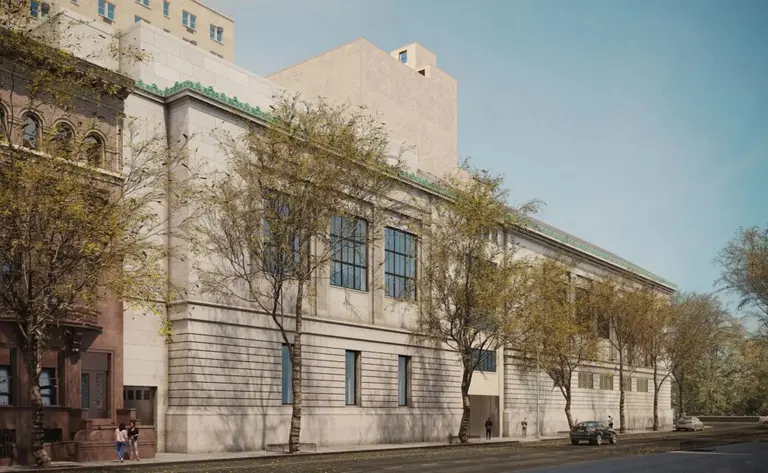The History of Symphony Space: From the Astor Market to the Leonard Nimoy Thalia

We were saddened here at 6sqft to hear about the passing last week of Leonard Nimoy, an extraordinary actor, director, poet, singer, and photographer, known worldwide for his role as Mr. Spock in “Star Trek.” Closer to home, though, Nimoy was also known as a dedicated philanthropist who adored the Upper West Side’s Symphony Space. In fact, in 2002 the multi-disciplinary performing arts organization renamed its historic Thalia Theater the Leonard Nimoy Thalia to reflect their patron’s generosity.
Just like the storied career of Nimoy, Symphony Space has its own eclectic past, from its beginnings as a food market funded by Vincent Astor to the Crystal Palace skating rink and, finally, to a neighborhood institution frequented by the likes of Stephen Colbert and Cynthia Nixon.


The Astor Market, via the Library of Congress Flickr
The site at the southwest corner of Broadway and 95th Street was first developed in 1915 when Vincent Astor spent $750,000 to create the Astor Market, a two-story structure full of food stands that sold fruit, meat, fish, produce, and flowers at reasonable prices. The grand façade of the building was full of adornment with massive arched windows and a 290-foot painted frieze by William Mackay of farmers bringing their goods to market. Despite Astor’s backing, the market failed in just two short years.

Symphony Theater in the 1950s, the Thalia marquee is visible to the left; Via Untapped via Symphony Space
In 1917, Astor sold the market to Thomas J. Healy, who converted the space into the Crystal Palace skating rink. The smaller basement area became the Sunken Gardens restaurant. By 1931, the rink had become the Symphony Theater and the basement the Thalia Theater, both movie houses. In the ’70s, it also doubled as a boxing and wrestling arena.

Symphony Theater in the 1980s; Via Untapped via Symphony Space
But in January 1978, something special happened. The late playwright Isaiah Sheffer and his friend, orchestral director Allan Miller, opened the padlocked doors of the Symphony Theater for Wall to Wall Bach, a free 12-hour music marathon dedicated to Johann Sebastian Bach in which the audience was invited to participate. Though the theater by this time was falling into disrepair and the neighborhood was crime- and drug-ridden, hundreds of people lined up outside to witness the event, and these two men realized that they had just found the centerpiece of the “Upper West Side Renaissance.” They leased the building, and Symphony Space was born in 1978.

The Thalia before becoming part of Symphony Space, via Cinema Treasures
The Thalia remained in operation separately until 1987. It was even featured in Woody Allen’s “Annie Hall.”

Symphony Space today, via Symphony Space via photopin (license)
After years of confusing real estate troubles, Symphony Space sold the air rights above the building for $10 million to the Related Companies in a controversial 2000 deal. Using this income, as well as donations from Peter Norton and Leonard Nimoy, the institution underwent a $12 million, two-year renovation that included the integration of the Thalia. The entirety of Symphony Space was renamed in honor of Norton’s gift, and the Thalia became the Leonard Nimoy Thalia.
Ennead Architects (then Polshek Partnership) preserved the 760-seat Symphony Theater (now called the Peter Jay Sharp Theatre), recreated the Thalia as a flexible venue, and renovated the lobby and box office. The firm also reimagined the exterior of Symphony Space, creating “a modernist composition made up of interlocking planes and blocks of glass, aluminum, and cement plaster,” wrapping the corner of 95th and Broadway.

The Lyric
Using the air rights, Related erected a 22-story, 277-unit apartment building, aptly called The Lyric, which rose above the modest theaters and encompassed the entire block of Broadway between 94th and 95th Streets, creating about 100,000 square feet of commercial space and 200,000 of residential space.
Today, Symphony Space still finds great success from its annual Wall to Wall event, as well as from the wildly popular Selected Shorts series, a national show that takes stories by well-known and emerging writers and has them performed by well-known stage and screen actors. The institution also offers countless other programs and performances, from comedy to literature to music to dance, and remains a cultural anchor of the Upper West Side.

Via Symphony Space
We asked Cynthia Elliott, President and CEO of Symphony Space, about the organization’s connection to Leonard Nimoy, and she told us:
Leonard Nimoy was not only a brilliant actor who graced our stages many times over the past 30 years; he was also a visionary whose generosity made possible the transformation of the old Thalia movie theatre into the beautiful, state-of-the-art Leonard Nimoy Thalia theatre it is today. He also produced, directed, wrote plays, had a brilliant photography career, could perform Shakespeare in Yiddish, and was a true Renaissance man. Symphony Space is honored and humbled to have had the privilege of his friendship and support.
RELATED:





































